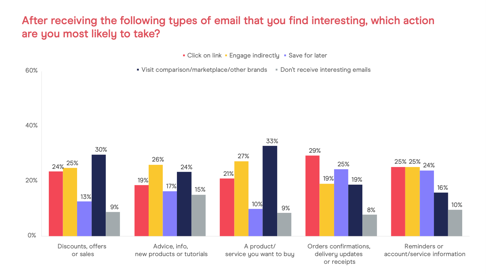When "One to Everyone" Email Messages Make Sense
First, the good news: For many years, experienced marketers have been preaching the advantages of targeting messages and using advanced segmentation for greater relevance, engagement and conversions, and marketers finally seem to be using these helpful tactics. Hooray!
Now, the bad news: Some marketers are taking the segmented-and-triggered approach a little too much to heart.
I'm hearing from many of our clients that they hesitate to email their entire active database for fear of sending too many irrelevant messages.
They're using their data to segment their databases and target their messages, which is great. But they're doing nothing to stay in touch with customers who open rarely, who don't fit any of their segmentation categories or who don't generate the behavior that would trigger a message – even something as basic as abandoning a browsing session or a cart.
Where open and click rates matter in campaign decisions
Sending campaigns only to subscribers who have opened emails recently is more problematic than ever thanks to Apple's Mail Privacy Protection feature. I've always warned marketers not to base business decisions on event metrics like opens or clicks just because of situations like these.
MPP can artificially inflate your opens. Bots can do the same for clicks. Although clicks are more tangible than opens, neither one is accurate enough to be the sole guide for deciding whether to send a campaign.
However, we can still make a case for using opens and clicks to target messages when we're trying to build engagement and have little or no other data, like conversions or web activity, to help us sort our customers into logical groups.
This "all or nothing" approach can have two serious consequences:
- Marketers can miss out on the chance to reach non-buyers or people who rarely open emails. If they aren't receiving emails, they can't open, click, and convert or generate the activities that determine segmenting or triggers.
- These customers, who have little or no engagement data, therefore often end up in the inactive file. It's not that they weren't interested – they got overlooked by narrow segmentation and automation rules that they didn't fit. This artificially deflates your active audience and wastes the money you spent to acquire these subscribers.
I'm certainly not advocating that we go back to sending the same campaign to every subscriber regardless of other data we have on them. But an effective email marketing strategy also needs to include default campaigns to reach subscribers who don't fit segmentation or triggering criteria.
Using the nudge effect to maintain a connection to non-buyers
When you contact only people who are in the buying cycle, you don't give your non-buyers a chance. It becomes a self-fulfilling proposition: you get buyers only when you target them.
Keep segmenting your database and optimizing your rules for your automations. But also develop a plan to reach customers who don't fit into the average buying cycle.
When you add a campaign to reach people who wouldn't otherwise receive one – like seldom-openers or people who don't enable images (so their opens don't get counted) – your emails will show up in their inboxes without needing to have your customers do anything other than opt in to receive them.
This lets you take advantage of the "nudge effect," a phenomenon Dela Quist of Alchemy Worx identified several years ago. Just seeing your emails in the inbox can be enough to keep your brand top of mind until your customer is back in the market and needs your products. Many of your recipients are already saving emails for later, according to findings in the DMA’s 2021 Consumer Tracker report:

Among my clients, it’s not unusual to see subscribers acting on email campaigns up to 8 weeks after delivery!
If you don't email customers unless they match your segmentation criteria or trigger an automated email, your brand will be absent from the inbox, but your competitor’s emails may be there instead.
Suppose you target campaigns just to customers who have opened emails or bought recently. You'll skip over customers who don't buy often, or who don't need your products until conditions are right in their own lives for them.
One of email’s strengths is that it’s a push channel. We don’t have to wait until someone searches for our brand or products before we message them. We can use this to surprise, delight, nudge and incentivize customers into action. Sometimes people just don’t know what they need or like until they see it in their inboxes!
Even though they may not be in the typical buying cycle for your products or be actively searching and opening to fulfill a need, just being in their inbox with the right product can be all they need to act.
Use your customer data to reduce the guesswork about the products you feature in these emails. Or send an informational message that helps customers buy successfully, sells your product benefits, shares recent positive customer reviews, or tells them about the people behind your brand.
If customers don't see your emails, how can they connect with your brand or buy from your company? They'll look as if they have gone inactive instead. You might then schedule them for a reactivation campaign or even remove them from your active database. Neither of those options would be appropriate here.
Real-life client example
Whilst performing an audit with a new client recently, we discovered they were doing an amazing job setting up, executing, and A/B testing their automations. One of the questions they wanted us to answer for them was whether they could stop sending broadcast campaigns, which went to all subscribers, and simply rely on targeted and triggered messages.
In our review, we saw the team's lifecycle email plan had accounted for every kind of action, touchpoint, even inactivity indicator that fit their brand and buying cycle. They had developed a sophisticated segmentation and automation plan using complex customer data. In other words, they were the kind of marketers people like me dream about!
Then, when we performed a send-reach analysis to discover how many subscribers had not been sent campaigns over the last six months, we discovered thousands of subscribers had not been sent an email during this period because they didn't fit the well-thought-out segmentation or triggered-messaging criteria.
As you evolve your email campaign strategy and tactics toward more specific segmentation categories and rely more on automated triggers, you must at the same time be certain that you aren't letting large groups of subscribers slip through the cracks.
Do what we did: Conduct a send-reach analysis to find how many subscribers you're overlooking now. This is calculated like open-reach or click-reach, but you are measuring how many subscribers received at least one email message from you in a set time period, such as three, six or 12 months. This will help you account for all of your potential recipients.
This reach metric is important because it is a subscriber-based metric, not a campaign metric that can be affected by outside factors.
Good email marketing isn't "either-or," it's "and"
For many brands, email marketing has become much more sophisticated, more so than even five years ago. ESPs give marketers of all team and budget sizes the tools to achieve the "right message to the right person" dream.
But as useful as these tools are, relying on them exclusively means large groups of subscribers can fall by the wayside because they don't fit into categories, rules or definitions. That can be as bad as relying only on broadcast email.
A sound email marketing needs a toolbox that's well-stocked with a mix of tactical approaches: a data-guided segmentation plan that you review and test frequently, a set of automated triggers to enhance the customer’s lifecycle and a well-thought-out program of default or catch-all campaigns for subscribers who don't meet your other criteria.
This balanced approach will help you tackle another problem – driving thousands or tens of thousands of interested subscribers into inactivity, and possibly the arms of your competitors, because you simply stopped sending messages to them.
 Photo by Olav Ahrens Røtne on Unsplash
Photo by Olav Ahrens Røtne on Unsplash

 How to resolve AdBlock issue?
How to resolve AdBlock issue? 